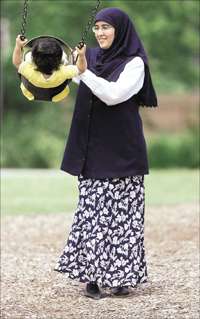

Muslim Women Say They Find Liberation in Modest AttireBy Jennifer Halperin Friday, May 19, 2000 Growing up in California, Norma Tarazi spent the early years of her life mired in a culture of miniskirts and hot pants, where many considered beauty and bare skin as worthy goals. So her conversion to Islam as an adult -- after which she adopted the style of dress known as hijab that covers much of the body and hair -- amounted to no small change in lifestyle. |

Dr. Asma Mobin-Uddin swings her daughter, Yasmine, 18 months, at a playground on the Northwest Side. |
|
The Qur'an calls for both Muslim women and men to dress modestly in public. Although Islam doesn't specify a style or form of dress, Suzanne Haneef writes in her book "What Everyone Should Know About Islam and Muslims" that a woman is required to "be completely covered except for her hands and face and that her dress should conceal her form, be loose and nontransparent, and not of a kind to attract attention by its beauty. "Many non-Muslim women might think of such dress as restrictive or even oppressive -- a sign of submission to men -- but those who have adopted hijab find it nothing less than liberating. "People gauge who you are by what you wear and what you look like; you can't get away from that," says Tarazi, who lives in Worthington and edits the IQRA! newsletter of the Islamic Society of Greater Columbus. "I used to feel uncomfortable (trying to keep up with) styles and looks. I was an intellectual type with glasses; I didn't go to the prom. Hijab frees you from trends and trying to keep up with appearances." Dr. Asma Mobin-Uddin, a local pediatrician who is vice president of the Ohio Chapter of the Council on American-Islamic Relations, finds irony in the perception that hijab somehow represents a woman's submission to her husband. "It's the total opposite of subordination," she says. "We wear it because we choose to; we refuse to let ourselves be sex objects. We're saying: 'Value us for what we are, our character, not how we look. We're not going to play the game of trying to look good for you. We won't let you hire us because you like our legs, or we'll look good around the office.' "In the West, I don't think women really see or realize how much you're tied to fashion, how much time you spend -- or waste, I should say -- dressing 'appropriately' and following fashion," Mobin-Uddin said. Hijab is an Arabic word meaning "curtain." Some use it to refer to the headdress many Islamic women wear; others use it to describe modest dress in general -- loose, unrestrictive clothing that covers the body, including Western-style blazers and long skirts. As religious and cultural groups unfamiliar with one another's practices begin to work and live together, misperceptions can arise, said Alam Payind, director of the Middle East Studies Center at Ohio State University. Sometimes these misperceptions have led to clashes. The city of Portsmouth, Va., for example, recently agreed to pay $100,000 each to two Muslim women who were arrested in 1996 for wearing veils in public. They were charged with violating a state law prohibiting the wearing of masks. The law, aimed at exposing Ku Klux Klan members, exempted people who cover their faces for religious reasons. In France, where Islam is the second-largest faith after Roman Catholicism, Muslim students often are expelled from schools for wearing Islamic attire. Last year, France's highest administrative court reaffirmed a ban on wearing hijab in public schools. "That's an ethnocentric mentality," Payind said. "You have women in the Middle East thinking they are more free than women here. Who is more free, they ask: Women who buy lipstick, are slaves to fashion, need new clothing every season and try to make themselves appealing to men? Somehow we all have the view that when others do things differently they are oppressed." Payind theorizes that misperceptions about hijab might be rooted in media reports about oppression of women in some Islamic nations, such as Afghanistan, ruled by the restrictive Taliban regime. But he notes that of the world's 56 Muslim countries, most don't require women to dress in any certain way; indeed, headscarves and other hijab coverings are discouraged in some, such as Turkey. The religious mandate of modest dress is hardly limited to Islam, he says; observant Jewish women, for example, are urged to cover their hair and bodies to hide their beauty in public. Nuns' habits are rooted in a religious call for modesty, as well. "What seems to be overlooked or misunderstood in the West," says Margaret Mills, chairwoman of OSU's Near Eastern Languages and Cultures Department, "is that hijab in a society often can be looked at as a way to 'decommercialize' women by looks, sexuality and fashion." Jennifer Halperin is a Dispatch editorial writer.
|
|